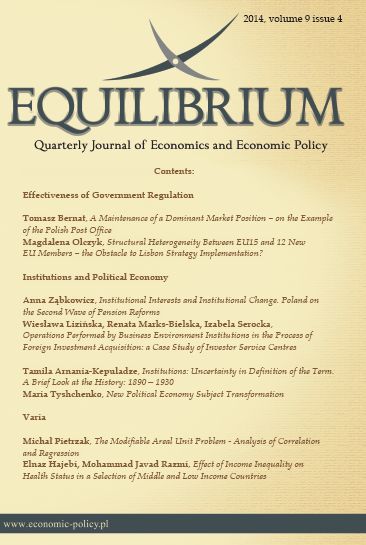The Modifiable Areal Unit Problem ? Analysis of Correlation and Regression
DOI:
https://doi.org/10.12775/EQUIL.2014.028Keywords:
spatial econometrics, modifiable areal unit problem, scale problemAbstract
The paper focuses on the issue of the modifiable areal unit problem, which means a possibility of obtaining various results for spatial economic analyses depending on the assumed composition of territorial units. The major research objective of the work is to examine the scale problem that constitutes one of the aspects of the modifiable areal unit problem. Analysis of the scale problem will be conducted for two research problems, namely, for the problem of the causal relationships between the level of investment outlays in enterprises per capita and the number of entities of the national economy per capita, and the issue of the dependence between the registered unemployment rate and the level of investment outlays per capita. The calculations based on the empirical values of those variables have showed that moving to a higher level of aggregation resulted in a change in the estimates of the parameters. The results obtained were the justification for undertaking the realisation of the objective. The scale problem was considered by means of a simulation analysis with a special emphasis laid on differentiating the variables expressed in absolute quantities and ones expressed in relative quantities. The study conducted allowed the identification of changes in basic properties as well as in correlation of the researched variables expressed in absolute and relative quantities. Based on the findings, it was stated that a correlation analysis and a regression analysis may lead to different conclusions depending on the assumed level of aggregation. The realisation of the research objective set in the paper also showed the need to consider the adequate character of variables in both spatial economic analyses and during the examination of the scale problem.
Downloads
References
Anselin, L. (1988). Spatial Econometrics: Method and Models. Netherlands: Kluwer Academic Publishers.
Arbia, G. (1989). Spatial Data Configuration in Statistical Analysis of Regional Economics and Related Problems. Dordrecht: Kluwer Academic Publisher.
Arbia, G. (2006). Spatial Econometrics, Statistical Foundations and Applications to Regional Convergence, Berlin-Heidelberg: Springer-Verlag.
Blalock, H. (1964). Causal inferences in nonexperimental research. Chapel Hill: University of North Carolina Press.
Flowerdew, R. (2011). How serious is the Modifiable Areal Unit Problem for analysis of English census data?. Population Trends, 145.
Holt, D., Steel, D. G., & Tranmer, M. (1996). Area homogeneity and the modifiable areal unit problem. Geographical Systems, 3.
Fotheringharn, A. S., & Wong, D. W. S. (1991). The modifiable area unit problem in multivariate analysis. Environment und Planning A, 23.
Gehlke, C. E., & Biehl, K. (1934). Certain Effects of Grouping Upon the Size of the Correlation Coefficient in Census Tract Material. Journal of the American Statistical Association, 29.
Manley, D., Flowerdew, R., & Steel, D. (2006). Scales, levels and processes: Studying spatial patterns of British census variables Computers. Environment and Urban Systems, 30.
Marble, D. F. (2000). Some thoughts on the integration of spatial analysis and Geographic Information Systems. Journal of Geographical Systems, 2.
Openshaw, S. (1977a). A geographical solution to scale and aggregation problems in region-building, partitioning and spatial modeling. Transactions of the Institute of British Geographers. New Series, 2.
Openshaw, S. (1977b). Algorithm 3: a procedure to generate pseudo-random aggregationsof N zones into M zones, where M is less than N. Environment and Planning A, 9.
Openshaw, S. (1977c). Optimal zoning systems for spatial interaction models. Environment and Planning A, 9.
Openshaw, S., & Taylor, P. J. (1979). A million or so correlation coefficients: three experiments on the modifiable areal unit problem In: N. Wrigley (Ed.). Statistical methods in the spatial sciences. London: Pion.
Openshaw, S. (1984a). The Modifiable Areal Unit Problem. Norwich: GeoBooks, CATMOG 38.
Openshaw S. (1984b). Ecological fallacies and the analysis of areal census data. Environment and Planning A, 16.
Openshaw, S. & Rao, L. (1995). Algorithms for re-engineering 1991 census geography. Environment and Planning A, 27.
Pietrzak, M. B. (2014a). Redefining The Modifiable Areal Unit Problem Within Spatial Econometrics. The Case Of The Scale Problem. Equilibrium, 9(2).
Pietrzak, M. B. (2014b). Redefining the Modifiable Areal Unit Problem within spatial econometrics, the case of the aggregation problem. Equilibrium, 9(3).
Reynolds, H. D. (1998). The Modifiable Area Unit Problem: Empirical Analysis by Statistical Simulation. Doctoral thesis, Graduate Deparment of Geography, University of Toronto.
Robinson, W. S. (1950). Ecological Correlations and the Behavior of Individuals. American Sociological Review, 15(3).
Suchecki, B. (2010). Ekonometria Przestrzenna. Warszawa: Wydawnictwo C.H.Beck.
Suchecki, B. (2012). Ekonometria Przestrzenna II. Warszawa: Wydawnictwo C.H.Beck.
Szulc, E. (2007). Ekonometryczna analiza wielowymiarowych procesów. Toruń: Wyd. UMK.
Tranmer, M. & Steel, D. (2001). Using Local Census Data to Investigate Scale Effects In: N. Tate, P. Atkinson (Ed.). Modelling scale in geographical information science. Chichester: John Wiley & Sons.
Yule, G. U. & Kendall, M. G. (1950). An introduction to the theoryof statistics. London: Griffin.
Zeliaś, A. (1991). Ekonometria Przestrzenna. Warszawa: PWE.






